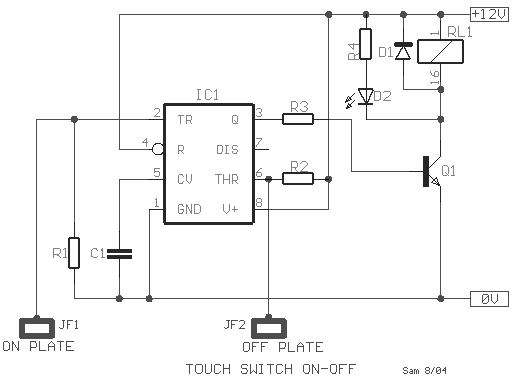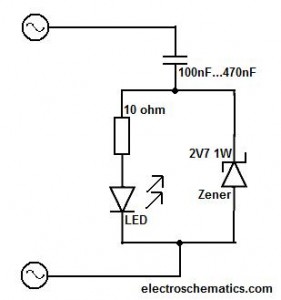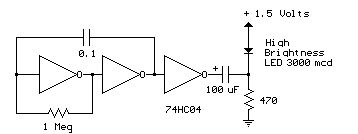
555 Touch Sensor Switch Circuit

This type of sensor switch is ideal for creating touch-operated bells and buzzers in small toys, which function for a limited duration before automatically shutting off. The trigger's input impedance is very high, allowing the touch sensor switch to be activated by the voltage induced in the human body. The circuit utilizes a 12 V DC relay that operates at currents less than 200 mA. A prototype of this circuit was tested on a breadboard; however, the relay activates without touch when powered on and remains energized even after the capacitor is fully charged.
The described touch sensor switch circuit employs a capacitive sensing mechanism to detect human touch. The high input impedance of the trigger allows for minimal current draw, making it efficient for battery-operated devices. When a person approaches the sensor, the body capacitance alters the electrical field surrounding the sensor, triggering the switch.
The relay used in this circuit operates at 12 V DC and is capable of handling loads up to 200 mA. This makes it suitable for controlling small devices such as bells and buzzers. The relay acts as a switch that closes when the sensor is activated, allowing current to flow to the output device.
In the breadboard prototype, the issue of the relay energizing without touch may be attributed to several factors. One potential cause could be noise in the circuit, which may be interpreted as a touch event. To mitigate this, it is advisable to incorporate debounce circuitry or filtering capacitors to stabilize the sensor's output. Additionally, the capacitor used for timing may need to be adjusted to ensure it discharges appropriately, allowing the relay to deactivate after the intended duration.
To further refine the design, consider adding a resistor in parallel with the capacitor to create a discharge path, ensuring that the relay does not remain energized indefinitely. Furthermore, a diode should be placed in parallel with the relay coil to prevent back EMF from damaging the circuit when the relay is deactivated.
Overall, careful attention to component selection and circuit layout will enhance the reliability and performance of the touch sensor switch in practical applications.This kind of sensor switch is suitable for making touch operated bells, buzzers of small toys which operate for a small time and then switch off automatically. The input impedance of the trigger is very high and the touch sensor switch can be triggered by the voltage induced in the human body.
The relay is a 12 V DC relay operating at currents les s than 200 mA. i tried a breadboard prototype of above circuit but not working relay energises without touch when powered on and keeps on even when capacitor is full charges. 🔗 External reference
The described touch sensor switch circuit employs a capacitive sensing mechanism to detect human touch. The high input impedance of the trigger allows for minimal current draw, making it efficient for battery-operated devices. When a person approaches the sensor, the body capacitance alters the electrical field surrounding the sensor, triggering the switch.
The relay used in this circuit operates at 12 V DC and is capable of handling loads up to 200 mA. This makes it suitable for controlling small devices such as bells and buzzers. The relay acts as a switch that closes when the sensor is activated, allowing current to flow to the output device.
In the breadboard prototype, the issue of the relay energizing without touch may be attributed to several factors. One potential cause could be noise in the circuit, which may be interpreted as a touch event. To mitigate this, it is advisable to incorporate debounce circuitry or filtering capacitors to stabilize the sensor's output. Additionally, the capacitor used for timing may need to be adjusted to ensure it discharges appropriately, allowing the relay to deactivate after the intended duration.
To further refine the design, consider adding a resistor in parallel with the capacitor to create a discharge path, ensuring that the relay does not remain energized indefinitely. Furthermore, a diode should be placed in parallel with the relay coil to prevent back EMF from damaging the circuit when the relay is deactivated.
Overall, careful attention to component selection and circuit layout will enhance the reliability and performance of the touch sensor switch in practical applications.This kind of sensor switch is suitable for making touch operated bells, buzzers of small toys which operate for a small time and then switch off automatically. The input impedance of the trigger is very high and the touch sensor switch can be triggered by the voltage induced in the human body.
The relay is a 12 V DC relay operating at currents les s than 200 mA. i tried a breadboard prototype of above circuit but not working relay energises without touch when powered on and keeps on even when capacitor is full charges. 🔗 External reference
Warning: include(partials/cookie-banner.php): Failed to open stream: Permission denied in /var/www/html/nextgr/view-circuit.php on line 713
Warning: include(): Failed opening 'partials/cookie-banner.php' for inclusion (include_path='.:/usr/share/php') in /var/www/html/nextgr/view-circuit.php on line 713





